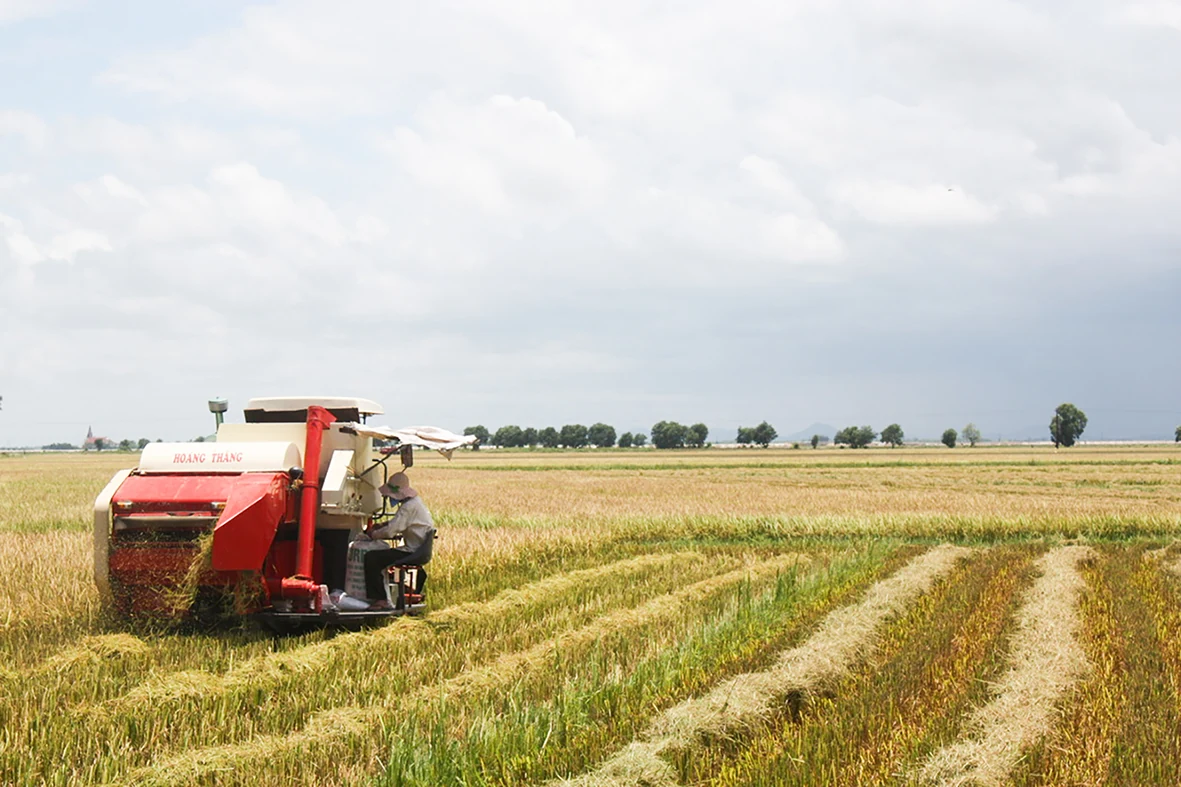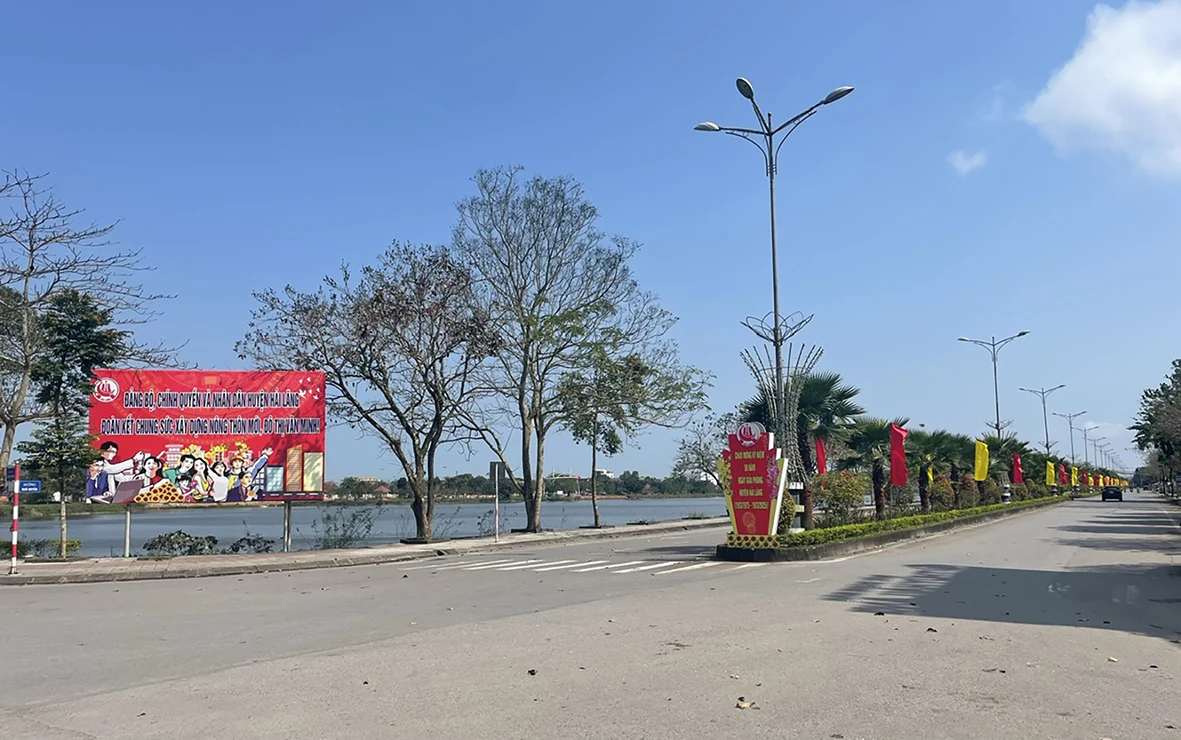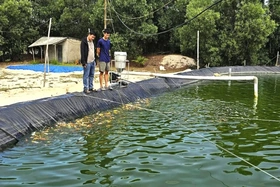{title}
{publish}
{head}
Fifty years after its liberation, Hai Lang District is nearing completion of its new rural development goals and has set its sights on becoming a key industrial hub of Quang Tri Province before 2030, aiming to achieve township status by 2040.
To achieve economic breakthroughs in this heroic land, realizing its vision and development aspirations, Hai Lang is preparing itself with determination and internal strength for the journey ahead. Among the districts in Quang Tri Province, Hai Lang possesses unparalleled advantages to create its own development opportunities both now and in the future.
Favorable conditions
Hai Lang is located just 40 kilometers south of centrally governed Hue City and slightly more than 20 kilometers from Dong Ha, the provincial capital. It is adjacent to Trieu Phong District and Quang Tri Town, with a fertile delta accounting for 32 percent of its total land area, making it the province’s rice production hub. To the west, it borders Dakrong District, where mountainous terrain makes up 55 percent of its land area. Once a battlefield ravaged by war and a gathering place for liberation forces, Hai Lang now boasts nearly 23,000 hectares of reforested land.

Crops harvesting in Hai Lang. Photo: D.T
The district also has a 14-kilometer-long coastline with extensive fishing grounds and coastal sand dunes covering 12 percent of its land area, approximately 6,600 hectares. These once barren and drought-ridden dunes, dominated by cacti, suffered from relentless shifting sands that tormented local lives throughout the year. Today, they have been transformed into ecological villages, yielding crops such as scallions and bitter melon, along with shrimp farms that generate significant income for farmers. According to economic experts, Hai Lang possesses an ideal mix of marine, delta, hilly, and forest resources.
One of Hai Lang’s major advantages is its transportation connectivity. The district lies along key national routes, including National Highway 1, National Highway 49C, and the planned National Highway 15D, which links La Lay International Border Gate to My Thuy Port. It also benefits from the North-South railway and the recently completed central axis road of the Southeast Quang Tri Economic Zone.
These infrastructure projects have improved transportation networks within the province, connecting National Highway 1 through Quang Tri Town to Cua Viet Port and My Thuy Port, passing through key tourism-service areas such as Cua Viet and Cua Tung. They also link the Southeast Quang Tri Economic Zone with other cities and provinces in the region.
Hai Lang is also renowned for its historical figures, including generals and scholars such as Nguyen Quan, Bui Duc Tai, and Nguyen Duc Hoan. Among them, Dr. Bui Duc Tai from Cau Nhi Village, Hai Tan Commune, became the first doctoral laureate of Dang Trong in 1502. Honored with an imperial title, his name is engraved on a stone stele at the Temple of Literature in Hanoi. He served as Deputy Minister of Personnel and Military Governor, and despite returning home for inspections, he never exploited his people. The resilience and integrity of Hai Lang’s people stem from their ancestors’ efforts to reclaim land, establish villages, and draft customary laws that have become deeply rooted traditions.
To develop tourism as a key economic sector, Hai Lang has begun leveraging its diverse natural and cultural resources. The district has identified 81 historical and cultural sites for preservation, restoration, and upgrading. Notable attractions such as Tra Loc Ecotourism Area, La Vang Church, and My Thuy Beach are already in operation, while potential sites like Choong Waterfall, Chan Hoang Waterfall, Cau Mung Lake, Heo Waterfall, Khe Khe Lake, Tram Lon, Tram Khang, and Tren Dam have been included in investment plans for infrastructure development and service expansion to attract visitors.

A major road in Dien Sanh Town, Hai Lang. Photo: D.T
Remarkable economic progress
In recent years, Hai Lang has achieved remarkable economic progress, outpacing other districts in Quang Tri. The total production value of its agriculture, forestry, and fisheries sector has reached approximately US$112.8 million. Agricultural production value per hectare stands at $4,980. Total grain output exceeds 90,000 tons annually. As the province’s rice hub, Hai Lang cultivates 13,637 hectares of rice across two annual crops, with an average yield of 6.47 tons per hectare. The district has also developed large-scale rice fields covering nearly 1,700 hectares, while high-quality rice varieties account for approximately 9,600 hectares, and organic rice cultivation spans 410 hectares. Other key crops include scallions and bitter melon in the sandy areas and citrus fruits in the K4 region, all of which provide stable income for local farmers.
Reflecting on rice farming in Hai Lang, journalist Dinh Nhu Hoan once recounted in a 2004 essay that producing rice here requires three to four times the effort compared to other regions. During the Tet holiday in 2000, he accompanied provincial leaders on a visit to local farmers. By 8 a.m. on the first day of the lunar new year, the villages were deserted. It turned out that from midnight, villagers had been out in the fields draining water to save their crops. At the time, out of the district’s 21 communes and towns, 10 were classified as deep-lying and flood-prone areas.
The entire rice-growing area of Hai Lang lies nearly one meter below sea level. Each flood season brings devastating torrents from the O Lau River and the surrounding sand dunes, submerging fields under three to four meters of water. Maintaining annual rice cultivation on 13,637 hectares with an average yield of 6.47 tons per hectare is, therefore, a tremendous achievement.
Reading the 2015 anthology “Poetry and Literature of Hai Lang,” one finds the poem “Hanh Hoa Village” by poet Le Ngoc Phai, with evocative lines: “Hanh Hoa, oh! Dust swirls with the falling leaves / The four corners of the world still remember our land.” These verses bring to mind a couplet by Du Mu, a poet of China’s late Tang Dynasty: “Where is the finest tavern, I ask? / The shepherd boy points to Hanh Hoa Village.”
Whether the Hanh Hoa Village in Le’s poem is real or imaginary, Hai Lang has long been famous for its specialty liquor, Kim Long My Tuu. The “Dai Nam Nhat Thong Chi” chronicles, in its eighth volume under the “Local Products” section, acknowledges: “Kim Long wine of Hai Lang is the finest and taxable.” Despite the passage of time, this traditional liquor, crafted from the region’s water, rice, yeast, and fire, remains as exquisite today as ever.
Hai Lang is not only famous for its renowned Kim Long liquor. Today, the region’s specialties are increasingly recognized as OCOP products. Among them is My An fish sauce, which has earned a 4-star rating, along with 20 other 3-star products, including Dai An Khe moon-shaped Tet cake, Hue banh loc, Hai Duong shallots, My Thuy fish sauce, Ba Vay ground shrimp paste, seaweed peanut salt, Hai Linh cereal, Hai Lang rice, K4 oranges, Phuong Anh lemongrass peanut salt, Bao Ngoc cajeput essential oil, Hai Dinh chili powder, Hai Phong chili sauce, Hai Son lotus seeds, freeze-dried shallots, freeze-dried bitter melon, fresh lotus seeds, Hai Hung dried lotus seeds, soft-dried bananas, and Quang Lam oranges.
As Hai Lang moves forward in its development, the industrial and cottage industries, along with rural trades, are being prioritized for investment, laying the groundwork for the district to become Quang Tri province’s key industrial hub by 2030. The district currently has 2,610 industrial and cottage industry establishments employing 7,795 workers. There are 34 projects being developed across three industrial clusters, creating jobs for more than 2,400 workers. The occupancy rate of Dien Sanh Industrial Cluster has reached 100 percent, while Hai Thuong Industrial Cluster is at 63 percent and Hai Chanh Industrial Cluster at 67.5 percent. The district has effectively implemented Resolution No. 06-NQ/HU, issued on December 13, 2022, concerning industrial and cottage industry development through 2030, alongside policies supporting industrial promotion activities for the 2021-2025 period. The average production value of the industrial and cottage industries stands at approximately 134 million USD, marking an increase of 130 million USD compared to 2010.
In addition, Hai Lang is attracting and implementing two key provincial projects: the Southeastern Quang Tri Economic Zone and the Quang Tri Industrial Park. The Southeastern Quang Tri Economic Zone spans a total area of 23,792 hectares, with Hai Lang accounting for 9,167 hectares of the zone, covering six communes: Hai Ba, Hai Hung, Hai Que, Hai Duong, Hai An, and Hai Khe. A total of 14 projects are planned for this area, which is already home to factories producing precast concrete components, commercial concrete, organic rice processing, industrial shrimp farming on sandy soil, stainless steel and alloy steel manufacturing, and aluminum billet production from recycled materials. Notably, the My Thuy Port project is under construction with a total investment exceeding 560 million USD, covering a land and water area of 685 hectares, with Phase 1 currently underway. The Quang Tri Industrial Park spans 481.2 hectares with a total investment of approximately 82 million USD, and Phase 1 construction is in progress. These projects provide a significant foundation for industrial, commercial, and service development, opening up new investment and economic growth opportunities for the district in the coming years.
Aiming to achieve town status by 2040, Hai Lang is implementing synchronized measures to gradually complete its urban planning and develop socio-economic infrastructure. Key projects include the Hai Lang District Master Plan for 2040, with a vision toward 2050; the General Plan for Dien Sanh Town through 2030, with a vision toward 2035; and the General Plan for the new La Vang urban area through 2045, all of which have been approved by the provincial People’s Committee. Meanwhile, planning for urban-industrial service zones around the VSIP project and the General Plan for the development of communes across the district through 2035 is currently being executed.
The achievements of any land in the future are often rooted in the aspirations and realities built and nurtured today. On the journey to becoming Quang Tri’s key industrial district by 2030 and attaining town status by 2040, Hai Lang enjoys many favorable conditions, having made thorough preparations for the future.
This preparation is founded on a keen foresight into the district’s developmental path, shaped by the people of Hai Lang, who draw strength from a rich cultural tradition and a deep historical heritage in this heroic homeland.
Dan Tam - Ngoc Mai

QTO - In Quang Tri, clean agricultural stores may not flaunt flashy signs or wide storefronts, but they are quietly becoming trusted places where consumers...

QTO - In a quiet village in central Vietnam, Le Minh Duc, 26, has turned his passion for ornamental fish into a promising startup, the first Koi breeding...